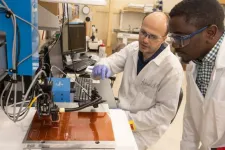By 2030, roughly half of Americans are expected to have obesity, a condition that contributes to the onset of chronic diseases, including diabetes and cancer. While previous research has highlighted connections between sleep, eating patterns, and weight gain, scientists remain uncertain of the role of the circadian system—our internal biological clock—in shaping eating patterns. A new study by investigators from Mass General Brigham and the Warren Alpert Medical School of Brown University reveals a distinct relationship between circadian rhythms, weight, and eating habits in teens, a vulnerable age group whose eating patterns influence their life-long health. In the study, adolescents who had overweight or obesity consumed more calories later compared to participants with healthy weights, with results demonstrating that circadian rhythms play a critical role in explaining later caloric intake in individuals at risk for obesity. Results are published in the Proceedings of the National Academy of Sciences (PNAS).
“Going into this study, we knew that the circadian system affects hunger and metabolism. What remained unclear, however, was whether the circadian system—when isolated from influences of environmental and behavioral cycles, including the light, sleep, and activity cycles—directly influences food consumption,” said Frank A.J.L. Scheer, PhD, a professor of Medicine and director of the Medical Chronobiology Program at Brigham and Women’s Hospital, a founding member of the Mass General Brigham healthcare system. “This study is the first to demonstrate that food intake itself is regulated by our internal body clock.”
Adolescents in the obesity and overweight groups consumed significantly more calories in the circadian evening compared to those in the healthy weight group. Researchers found no significant differences in total sleep time between or within the groups across sleep cycles.
The circadian system is composed of trillions of clocks present in virtually all organs, tissues, and cells, which prepare our biology and behavior to the changing demands across the day/night cycle. The influence of the circadian system is known to differ between people, due to a combination of genetic, behavioral, and environmental factors. This study uniquely highlights the correlation between weight class, calories consumed, and circadian rhythms in adolescents, an under-researched population whose current eating patterns will play a crucial role in shaping their long-term health as adults.
Fifty-one male and female adolescents between the ages of 12 and 18 (mean age of 13.7 years) participated in this study. Teens were divided into three groups based on body mass index (BMI). Twenty-four were in the healthy weight group, 13 in the overweight group, and 14 in the obesity group. All participants lived on seven 28-hour sleep and wake cycles, staying in a controlled dim light setting while awake and in complete darkness during sleep. Participants stayed in the same space throughout the study. To control for outside influences on circadian rhythm, researchers removed all external time cues from the lab’s environment, including clocks and access to outside light.
Participants received six opportunities to eat at fixed times across the wake episode, with a standardized menu. Participants could consume as much food during each meal as they would like. Researchers tracked food eaten and caloric intake. During the day, teens could participate in a variety of activities including crafts, watching movies (with screen lights dimmed), and playing social games.
The results showed that changes in the circadian system throughout the day and night significantly influenced food consumption across all participants. In all three groups, food intake peaked in the late afternoon and early evening and was lowest in the morning, even after accounting for behavioral and environmental factors, demonstrating that the body’s biological clock directly impacts how much we eat at different times of the day.
While this study demonstrated the impact of the circadian system on food intake and revealed differences between groups based on weight, it cannot test the “chicken and egg” question of which comes first. Future studies are needed to determine whether affecting circadian control of food intake contributes to weight changes, if weight changes impact the circadian control of food intake, or a combination of the two. With future research, Scheer aims to gain a deeper understanding of the interactions between diet, the circadian system, and metabolism, the biological mechanisms underlying these relationships, and the implications for developing timed dietary interventions to improve health.
“The critical nature of adolescent development to set the stage for a lifetime of health highlights the need to understand the roles played by sleep/wake and circadian timing processes for eating behavior,” said the study’s lead investigator Mary A. Carskadon, PhD, of the Warren Alpert Medical School. “The knowledge gained here opens a door to potential interventions that can enhance teen health moving forward.”
Authorship: Additional authors include David H. Barker, Mary A. Carskadon, Caroline Gredvig-Ardito, Chantelle N. Hart, and Hollie A. Raynor.
Disclosures: Scheer served on the Board of Directors for the Sleep Research Society and has received consulting fees from the University of Alabama at Birmingham and Morehouse School of Medicine. Scheer’s interests were reviewed and managed by Brigham and Women's Hospital and Partners HealthCare in accordance with their conflict-of-interest policies. Scheer’s consultancies are not related to the current work. Hart has received consulting fees from the University of South Carolina and serves as a consultant on a grant funded by the Novo Nordisk Foundation. Hart’s interests were reviewed and managed by Temple University in accordance with their conflict-of-interest policies. These consultancies are unrelated to the current work.
Funding: This work was supported by NIDDK grant R01 DK101046; by the NHLBI grant R01HL153969; and by the COBRE Center for Sleep and Circadian Rhythms in Child and Adolescent Mental Health funded by the NIGMS grant number P20GM139743. The content is solely the 516 responsibility of the authors and does not necessarily represent the official views of the National Institutes of Health. Scheer was supported in part by the National Institutes of Health (R01-HL140574; R01-HL153969; R01-HL167746; R01-HL164454).
Paper cited: Barker, D. et al. “Independent Effects of Human Circadian System and Sleep/Eating Cycles on Caloric Intake in Adolescents Dependent on Weight Status” Journal DOI: 10.1073/pnas.2407907122
###
About Mass General Brigham
Mass General Brigham is an integrated academic health care system, uniting great minds to solve the hardest problems in medicine for our communities and the world. Mass General Brigham connects a full continuum of care across a system of academic medical centers, community and specialty hospitals, a health insurance plan, physician networks, community health centers, home care, and long-term care services. Mass General Brigham is a nonprofit organization committed to patient care, research, teaching, and service to the community. In addition, Mass General Brigham is one of the nation’s leading biomedical research organizations with several Harvard Medical School teaching hospitals. For more information, please visit massgeneralbrigham.org.
END



